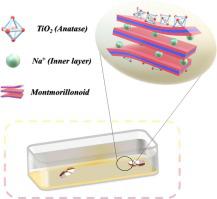Inorganic Chemistry Communications ( IF 4.4 ) Pub Date : 2021-01-16 , DOI: 10.1016/j.inoche.2021.108464 Shuyi Yang , Xinyu Xiao , Tao E

|
In this work, titanium dioxide surface modified montmorillonite (TMC) were prepared by sol–gel method, so as to improve its selective adsorptivity for trivalent chromium ions (Cr3+). When it was applied to remove low concentration of Cr3+(10 mg/L) from wastewater, the remaining concentration of Cr3+ was less than 1.5 mg/L, meeting the emission standard required by the Chinese Environmental protection agency (GB4287-92). The phase, structure and morphology of TMC were determined by means of XRD, CEC, IR, Raman, XPS, SEM, TEM and BET. It was found that titanium dioxide (TiO2) was uniformly dispersed on the surface of montmorillonite (MMT), and the spacing of MMT layer was almost unchanged via filling with Na+, so that the selective adsorptivity of MMT for Cr3+ was achieved. At the same time, theoretical calculations based on first principles and density functional theory confirmed the adsorption selectivity of MMT for Cr3+. In addition, the structural advantages of TMC addressed the shortcomings of MMT surface negative potential that it could not perform adsorption selectivity. Moreover, the adsorptive process of Cr3+ with TMC followed the pesudo-second-order kinetic equation, and Langmuir equation could better describe the adsorption mechanism (the maximum adsorption capacity was 194.1 mg/g). After five cycles, the removing efficiency was still over 89%. Therefore, TMC accompanied with high selective adsorptivity, simple synthesis process, as well as high regenerative performance, had great potential for removing low concentration of Cr3+ from wastewater.










































 京公网安备 11010802027423号
京公网安备 11010802027423号